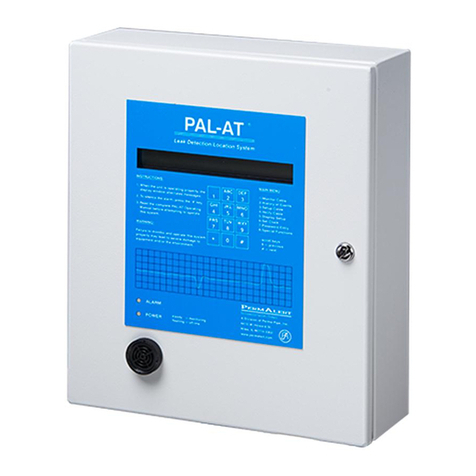
PAL-AT Installation Manual
5
1 Introduction
1.1 General Description
This PAL-AT®Installation Manual is intended for use as a general installation guide for PAL-AT
alarm/locator panels, sensor cable, cable connectors, and probes. Users (installers) should
independently evaluate the suitability of this information and PermAlert's products for their application
and specific installation. If you receive a PermAlert product that is not described in this manual, contact
PermAlert for the appropriate instructions. Refer to the website, permalert.com (permapipe.com), for the
latest revision of manuals and product data sheets.
1.2 Applications
The PAL-AT system consists of an electronic microprocessor-based alarm/locator panel that monitors
sensor cables and/or probes. The sensor cable may be installed in many applications including:
secondary contained piping, directly in the ground adjacent to pipes or tanks; computer room subfloors;
cleanroom subfloors, or any area where liquids need to be detected. There are several PAL-AT models
available including:
AT20C: Monitors 1 cable up to 2,000 feet.
AT50C: Monitors 1 cable up to 5,000 feet.
AT20K: Monitors up to 2 cables each up to 7,500 feet.
AT40K: Monitors up to 8 cables each up to 5,000 feet.
AT80K: Monitors up to 8 cables each up to 7,500 feet.
1.3 Receiving and Handling Precautions
The following general precautions should be observed:
1. Read this manual carefully before beginning any work. Do not use substitute materials or
short cut recommended procedures. Understanding and following this guide is essential to
avoid installation problems.
2. Collect the needed quantities of all materials well in advance of scheduled work.
3. Check the packing list against received items. Report immediately any shortages or
damaged materials to PermAlert's delivering carrier.
4. All cable must be tested immediately upon receipt following the cable test procedures contained
in this manual. Report immediately to PermAlert any cables that fail this quality control test.
Failure to report within ten workdays of receipt of goods shall waive the purchaser's right to file a
warranty claim.
5. Care must be taken to store all PAL-AT components in a dry and protected area at all times.
Electronic alarm/locator units and sensor cable should be wrapped and sealed with plastic.
6. System drawings, provided by the designer, should indicate the extent, general location, and
arrangement of leak detection equipment, cable, and probes. The contractor (installer) should
become familiar with all details of the installation before proceeding.
7. Electrical work should be performed by a qualified electrician.
1.4 Materials and Equipment Normally Supplied by PermAlert
Each system may include the following items as quoted:
1. Leak detection/location alarm panel
2. Leak sensor cable
3. Jumper cable
4. Cable connector assemblies
5. Adhesive backed cable mounts (CMA) furnished for attachment of sensor cable to flat surfaces





























